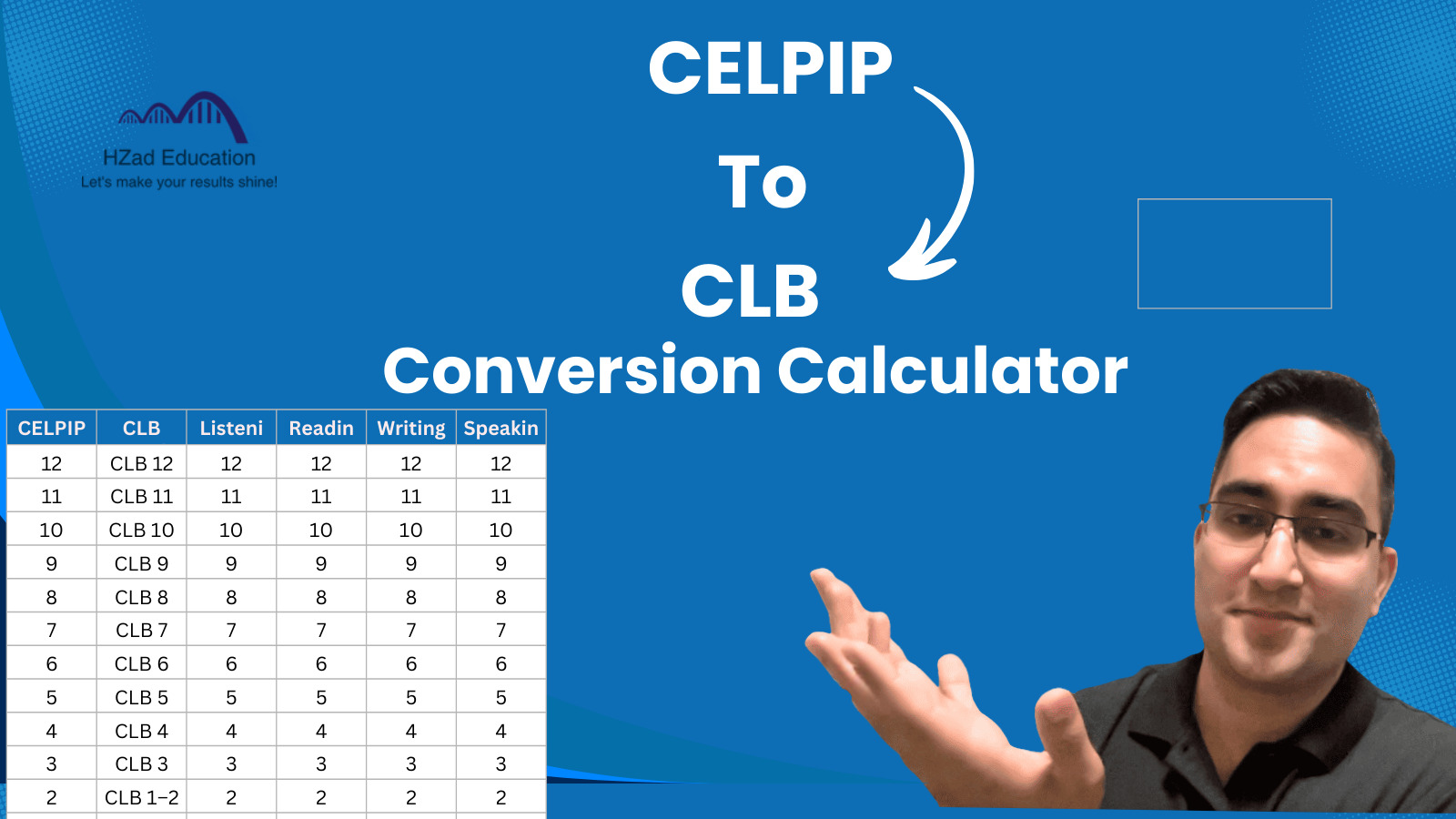Completing the CELPIP test is only the first step for many applicants. The next challenge is understanding how these results translate into the Canadian Language Benchmarks (CLB) system, which is the standard used by Immigration, Refugees and Citizenship Canada (IRCC) to measure English language proficiency. Since immigration programs such as Express Entry and the Provincial Nominee Program (PNP) require CLB levels rather than raw CELPIP scores, accurate conversion is essential.
To simplify this process, the CELPIP to CLB Conversion Calculator takes your test results in Listening, Reading, Writing, and Speaking and instantly shows the equivalent CLB levels, which range from CLB 1 (basic) to CLB 12 (advanced). This tool is especially valuable for skilled workers, international graduates, and citizenship candidates who need to demonstrate their language proficiency to qualify for Canadian immigration.
This page will guide you through the calculator, explain how it works, provide a conversion chart, and outline the full process, ensuring you can check your eligibility with confidence.
CELPIP to CLB Conversion Calculator Tool
Enter your CELPIP scores for each section to determine your Canadian Language Benchmark (CLB) levels.
Enter Your Scores
Your CLB Scores
| Skill | CELPIP Score | CLB Level |
|---|---|---|
| Overall CLB Level | ||
Conversion Chart
| CLB Level | CELPIP Score |
|---|---|
| 10 | 10–12 |
| 9 | 9 |
| 8 | 8 |
| 7 | 7 |
| 6 | 6 |
| 5 | 5 |
| 4 | 4 |
| 3 | 3 |
| Below 3 | 0, 1, 2 |
CELPIP to CLB Conversion Chart
Instead of relying solely on the calculator, applicants can use the CELPIP to CLB conversion chart to directly compare their CELPIP scores in Listening, Reading, Writing, and Speaking with the corresponding Canadian Language Benchmarks (CLB) levels. For example, a CELPIP score of 7 in Writing equals CLB 7, which is often the minimum requirement for certain immigration pathways. This provides a clear and reliable way to manually verify CLB levels based on test results, helping applicants understand whether their scores meet the language requirements for Canadian immigration.
| CELPIP Score | CLB Level | Listening | Reading | Writing | Speaking |
| 12 | CLB 12 | 12 | 12 | 12 | 12 |
| 11 | CLB 11 | 11 | 11 | 11 | 11 |
| 10 | CLB 10 | 10 | 10 | 10 | 10 |
| 9 | CLB 9 | 9 | 9 | 9 | 9 |
| 8 | CLB 8 | 8 | 8 | 8 | 8 |
| 7 | CLB 7 | 7 | 7 | 7 | 7 |
| 6 | CLB 6 | 6 | 6 | 6 | 6 |
| 5 | CLB 5 | 5 | 5 | 5 | 5 |
| 4 | CLB 4 | 4 | 4 | 4 | 4 |
| 3 | CLB 3 | 3 | 3 | 3 | 3 |
| 2 | CLB 1–2 | 2 | 2 | 2 | 2 |
| 1 | – | 1 | 1 | 1 | 1 |
| 0 | – | 0 | 0 | 0 | 0 |
This chart is especially helpful for applicants aiming for Express Entry, Provincial Nominee Programs (PNPs), or Canadian citizenship, since each pathway specifies minimum CLB levels. By cross-referencing CELPIP scores with this table, users can independently confirm whether their results meet program requirements or if retaking the test might be necessary.
How the CELPIP to CLB Conversion Calculator Works?
The CELPIP to CLB Conversion Calculator takes your CELPIP scores in Listening, Reading, Writing, and Speaking and converts them into equivalent CLB levels using the official benchmarks established by IRCC. This allows you to compare your results with the language requirements for immigration programs such as Express Entry and the Provincial Nominee Program (PNP).
Steps in the CELPIP to CLB conversion process:
- Enter your CELPIP scores in Listening, Reading, Writing, and Speaking.
- The calculator applies IRCC benchmarks to match each score with the correct CLB level.
- View your results as each CELPIP score is shown with its CLB equivalent.
- Check your CLB profile and compare it with the minimum requirements of your immigration program.
Here are some CELPIP to CLB conversion examples:
- CELPIP 7 in Writing → CLB 7
- CELPIP 8 in Listening → CLB 8
- CELPIP 9 in Reading → CLB 9
- CELPIP 10 in Speaking → CLB 10
This process gives you a quick and reliable way to confirm whether your scores meet the language proficiency standards for Canadian immigration and citizenship.
Why Use the CELPIP to CLB Conversion?
The CELPIP to CLB conversion is essential because IRCC evaluates immigration and citizenship applications by CLB levels, not CELPIP scores. By converting your Listening, Reading, Writing, and Speaking results into their CLB equivalents using IRCC’s official benchmarks, you can confirm whether you meet the specific language requirements for programs such as Express Entry, Provincial Nominee Programs (PNPs), and Canadian citizenship.
Key reasons and benefits for CELPIP to CLB conversion are:
- Meet program requirements:
Immigration pathways such as Express Entry, the Provincial Nominee Program (PNP), and citizenship applications require specific CLB levels. For example, Express Entry usually requires a minimum of CLB 7, while some PNP streams demand CLB 9 or higher.
- Ensure fair evaluation:
The conversion uses the official equivalency chart to standardize CELPIP results, giving IRCC a consistent way to assess English proficiency across applicants.
- Plan your immigration pathway:
Knowing your CLB level helps you identify whether you already qualify or if you need to retake CELPIP to improve your eligibility.
- Maximize immigration points:
Higher CLB levels increase points under the Comprehensive Ranking System (CRS) for Express Entry, directly affecting your chances of selection.
Using this conversion provides certainty and ensures your language proficiency results are accurately reflected in the immigration process.
Frequently Asked Questions (FAQs)
How do I know my CELPIP score?
You can find your CELPIP score in the official test report provided after completing the exam. Results are usually available online through your CELPIP account within 3 to 4 business days, showing your scores for Listening, Reading, Writing, and Speaking. Each section is scored separately on a 1 to 12 scale, which you can then convert into CLB levels using the calculator or chart. If you requested a paper copy, your official score report will also be mailed to you.
What CLB level is required for Canadian immigration?
The CLB level you need depends on the immigration program or application type you are pursuing. Each pathway sets its own language benchmarks, and knowing the correct CLB requirement helps you understand whether your CELPIP results are sufficient or if you may need to improve your scores. The main requirements are:
- Express Entry (Federal Skilled Worker Program): Minimum CLB 7 in each module is required to qualify. Higher levels, such as CLB 9 or above, can increase your Comprehensive Ranking System (CRS) score and improve your chances of selection.
- Provincial Nominee Programs (PNPs): Requirements vary by province, but most streams expect at least CLB 7 or CLB 8, while some may require CLB 9.
- Canadian Citizenship: Applicants must generally demonstrate CLB 4 or higher in Listening and Speaking.
How accurate is the CELPIP to CLB conversion?
The CELPIP to CLB conversion is accurate because it is based on the official equivalency chart published by Immigration, Refugees and Citizenship Canada (IRCC), which immigration officers use to assess applications. Both the online calculator and the conversion chart directly follow these government-approved benchmarks, making them a reliable and precise way to confirm your language proficiency for Express Entry, Provincial Nominee Programs (PNPs), and Canadian citizenship.
What if I have different scores for each module?
Each CELPIP module (Listening, Reading, Writing, and Speaking) may result in different scores, but the conversion chart or calculator helps you find the CLB level for each section and understand your overall language profile. For example, if a candidate scores Listening 9, Reading 8, Writing 7, and Speaking 8, the equivalent CLB levels would be CLB 9, CLB 8, CLB 7, and CLB 8. Together, these results reflect an average CLB 8, which can then be compared with the language requirements of Canadian immigration programs.
Can I convert my CELPIP score to IELTS or TEF?
Yes, you can convert CELPIP scores to approximate equivalents in IELTS or TEF using official conversion charts and tools provided for Canadian immigration. These charts compare results across the three tests, allowing applicants to understand how their CELPIP performance aligns with IELTS bands or TEF scores. Since each test uses a different scoring system, it is important to rely only on government-approved equivalency charts to ensure accuracy when checking eligibility for programs such as Express Entry or the Provincial Nominee Program (PNP).
How long does it take to get my CELPIP results?
CELPIP results are typically available within 3 to 4 business days after your test date. You can view them by logging into your CELPIP online account, where scores for Listening, Reading, Writing, and Speaking are posted. If you requested a paper copy during registration, an official score report is also mailed to you.
What if I want to retake the CELPIP exam?
Yes, you can retake the CELPIP exam as many times as needed to achieve your desired score. There is no official limit on the number of attempts, but you must wait at least 5 days before booking another test. Each retake requires paying the full test fee, and results from multiple attempts are treated independently. Many applicants choose to retake CELPIP if their initial scores do not meet the required CLB level for programs such as Express Entry or the Provincial Nominee Program (PNP).
Can I use the CELPIP score for Canadian permanent residency?
Yes, CELPIP scores are accepted by Immigration, Refugees and Citizenship Canada (IRCC) for permanent residency applications, including Express Entry and Provincial Nominee Programs (PNPs). All four sections (Listening, Reading, Writing, and Speaking) are assessed, with Listening and Speaking playing a key role in meeting CLB requirements and earning Comprehensive Ranking System (CRS) points. Converting your CELPIP results into Canadian Language Benchmarks (CLB) confirms whether your scores qualify for permanent residency.


